QUEEN ELIZABETH By Anna Mursekaeva Intro 1.
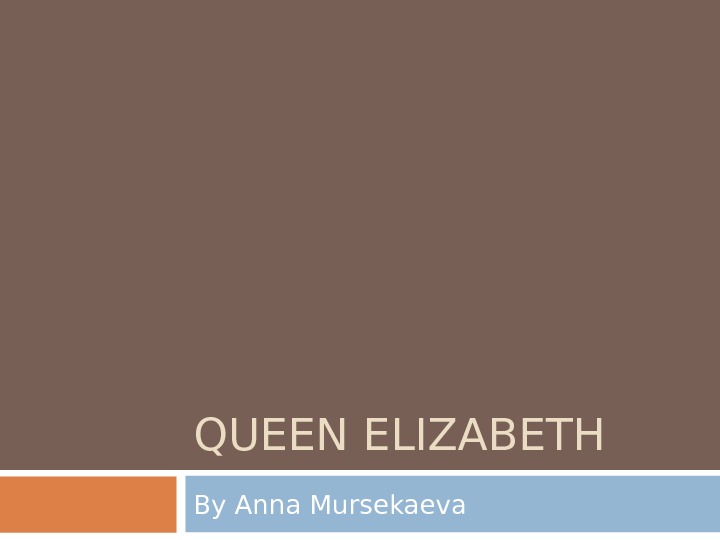
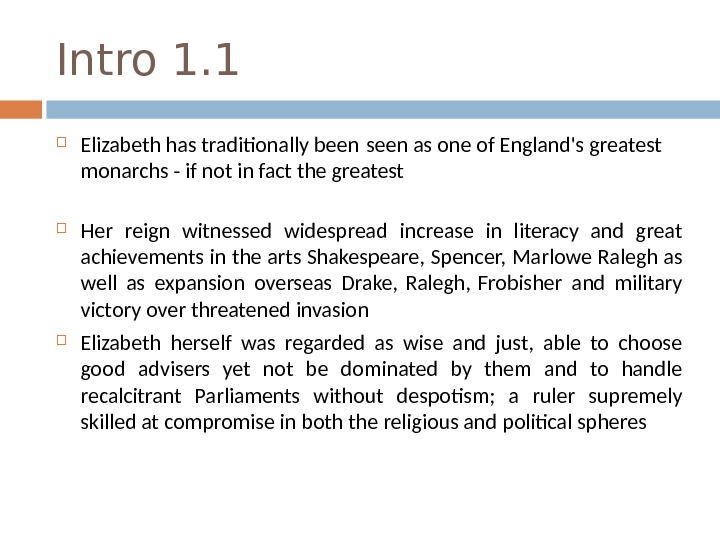
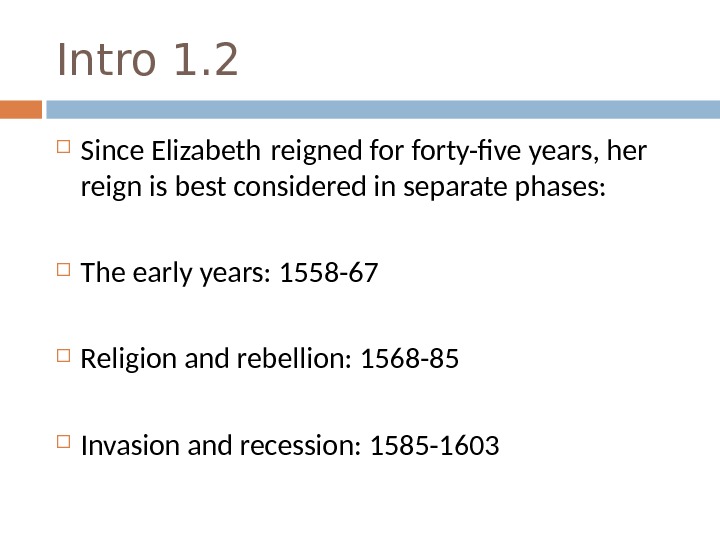
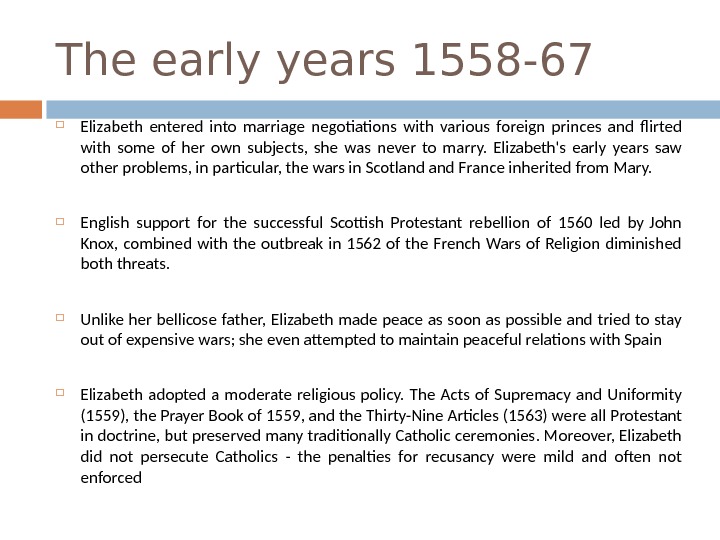
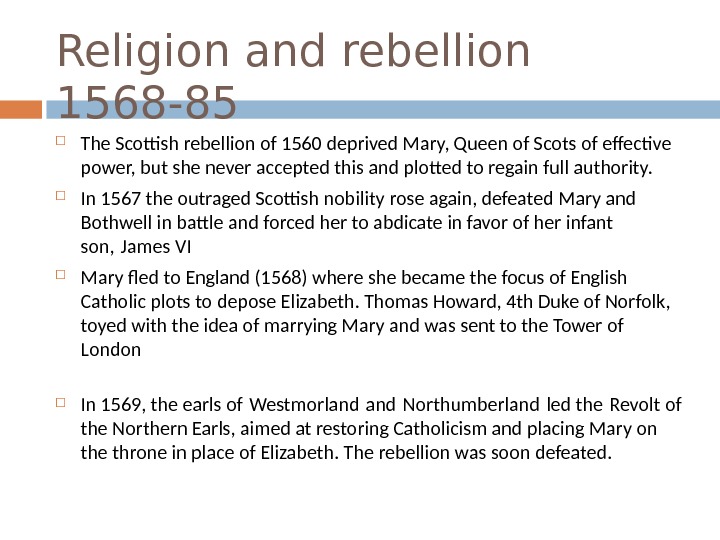
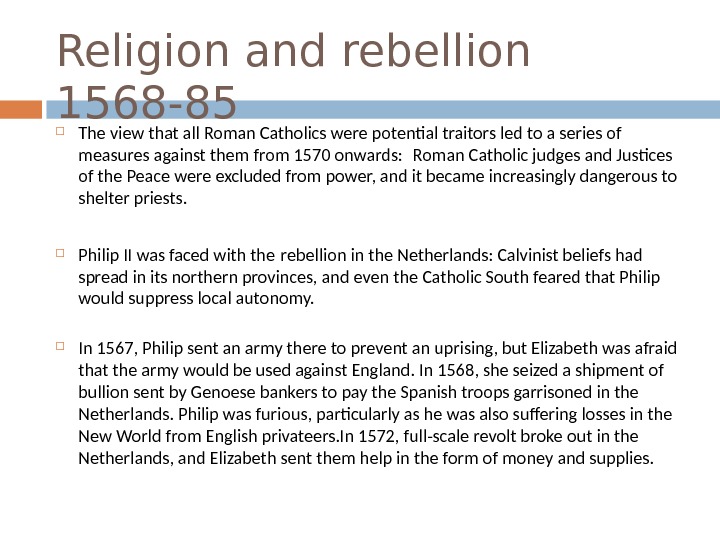
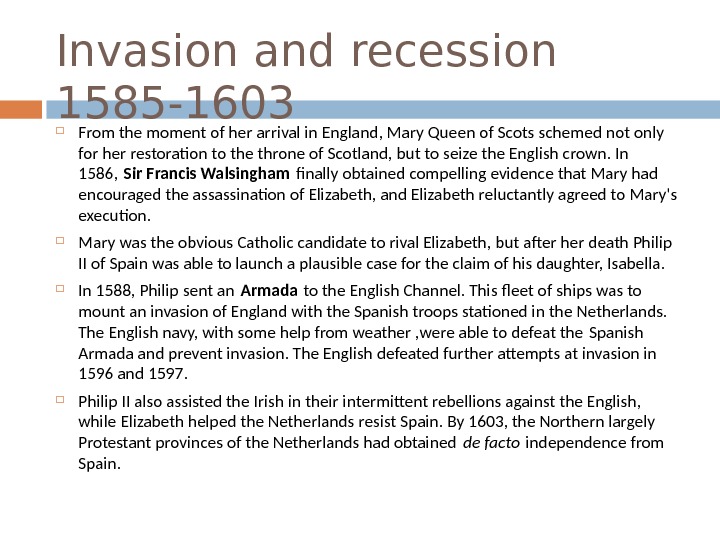
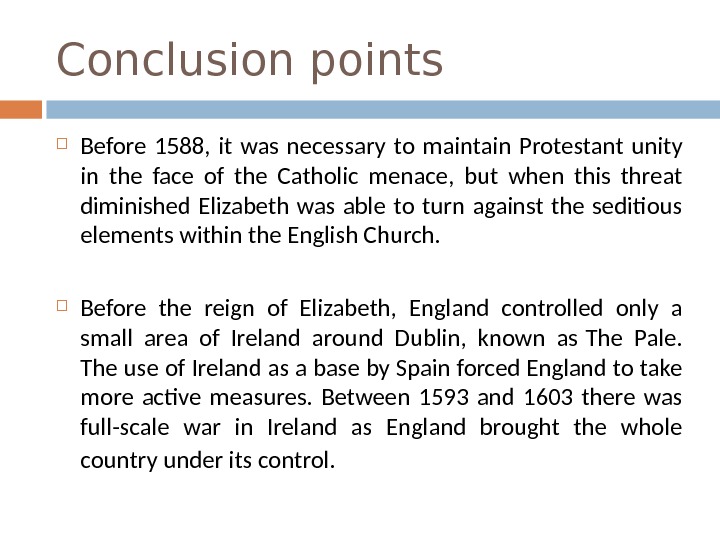
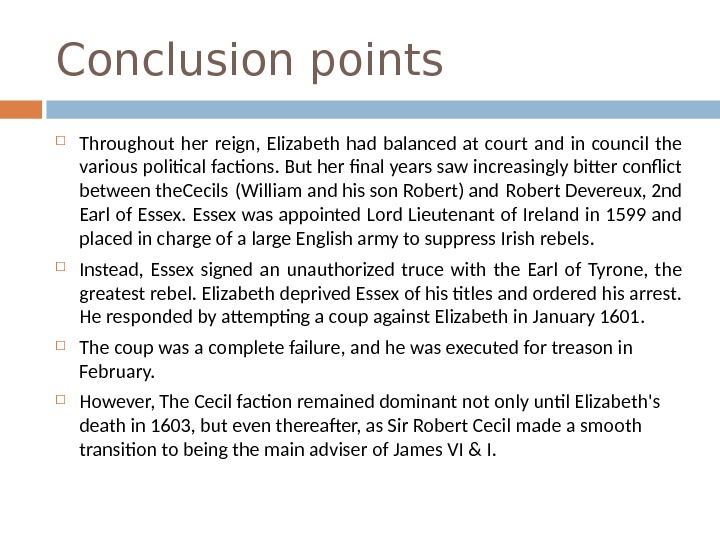
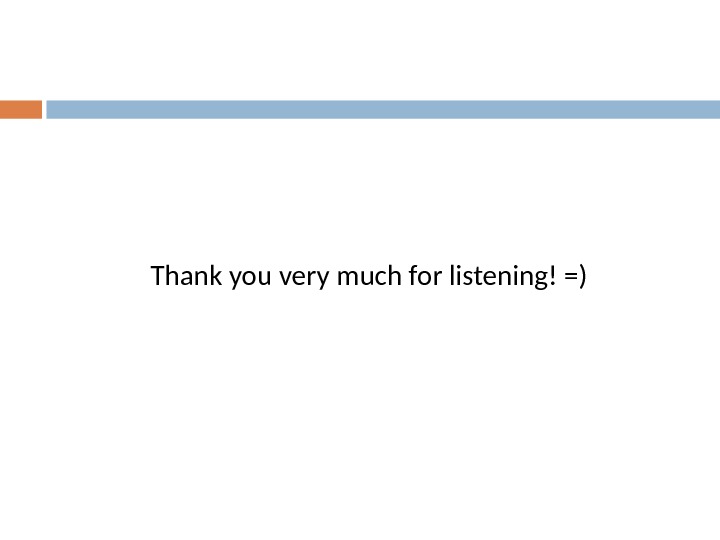
- Размер: 577.5 Кб
- Количество слайдов: 10
Описание презентации QUEEN ELIZABETH By Anna Mursekaeva Intro 1. по слайдам
 QUEEN ELIZABETH By Anna Mursekaeva
QUEEN ELIZABETH By Anna Mursekaeva
 Intro 1. 1 Elizabeth has traditonally been seen as one of England’s greatest monarchs — if not in fact the greatest Her reign witnessed widespread increase in literacy and great achievements in the arts Shakespeare, Spencer, Marlowe Ralegh as well as expansion overseas Drake, Ralegh, Frobisher and military victory over threatened invasion Elizabeth herself was regarded as wise and just, able to choose good advisers yet not be dominated by them and to handle recalcitrant Parliaments without despotsm; a ruler supremely skilled at compromise in both the religious and politcal spheres
Intro 1. 1 Elizabeth has traditonally been seen as one of England’s greatest monarchs — if not in fact the greatest Her reign witnessed widespread increase in literacy and great achievements in the arts Shakespeare, Spencer, Marlowe Ralegh as well as expansion overseas Drake, Ralegh, Frobisher and military victory over threatened invasion Elizabeth herself was regarded as wise and just, able to choose good advisers yet not be dominated by them and to handle recalcitrant Parliaments without despotsm; a ruler supremely skilled at compromise in both the religious and politcal spheres
 Intro 1. 2 Since Elizabeth reigned forty-fve years, her reign is best considered in separate phases: The early years: 1558 -67 Religion and rebellion: 1568 -85 Invasion and recession: 1585 —
Intro 1. 2 Since Elizabeth reigned forty-fve years, her reign is best considered in separate phases: The early years: 1558 -67 Religion and rebellion: 1568 -85 Invasion and recession: 1585 —
 The early years 1558 -67 Elizabeth entered into marriage negotatons with various foreign princes and flirted with some of her own subjects, she was never to marry. Elizabeth’s early years saw other problems, in partcular, the wars in Scotland France inherited from Mary. English support for the successful Scotsh Protestant rebellion of 1560 led by John Knox, combined with the outbreak in 1562 of the French Wars of Religion diminished both threats. Unlike her bellicose father, Elizabeth made peace as soon as possible and tried to stay out of expensive wars; she even atempted to maintain peaceful relatons with Spain Elizabeth adopted a moderate religious policy. The Acts of Supremacy and Uniformity (1559), the Prayer Book of 1559, and the Thirty-Nine Artcles (1563) were all Protestant in doctrine, but preserved many traditonally Catholic ceremonies. Moreover, Elizabeth did not persecute Catholics — the penaltes for recusancy were mild and often not enforced
The early years 1558 -67 Elizabeth entered into marriage negotatons with various foreign princes and flirted with some of her own subjects, she was never to marry. Elizabeth’s early years saw other problems, in partcular, the wars in Scotland France inherited from Mary. English support for the successful Scotsh Protestant rebellion of 1560 led by John Knox, combined with the outbreak in 1562 of the French Wars of Religion diminished both threats. Unlike her bellicose father, Elizabeth made peace as soon as possible and tried to stay out of expensive wars; she even atempted to maintain peaceful relatons with Spain Elizabeth adopted a moderate religious policy. The Acts of Supremacy and Uniformity (1559), the Prayer Book of 1559, and the Thirty-Nine Artcles (1563) were all Protestant in doctrine, but preserved many traditonally Catholic ceremonies. Moreover, Elizabeth did not persecute Catholics — the penaltes for recusancy were mild and often not enforced
 Religion and rebellion 1568 -85 The Scotsh rebellion of 1560 deprived Mary, Queen of Scots of effectve power, but she never accepted this and ploted to regain full authority. In 1567 the outraged Scotsh nobility rose again, defeated Mary and Bothwell in batle and forced her to abdicate in favor of her infant son, James VI Mary fled to England (1568) where she became the focus of English Catholic plots to depose Elizabeth. Thomas Howard, 4 th Duke of Norfolk, toyed with the idea of marrying Mary and was sent to the Tower of London In 1569, the earls of Westmorland Northumberland led the Revolt of the Northern Earls, aimed at restoring Catholicism and placing Mary on the throne in place of Elizabeth. The rebellion was soon defeated.
Religion and rebellion 1568 -85 The Scotsh rebellion of 1560 deprived Mary, Queen of Scots of effectve power, but she never accepted this and ploted to regain full authority. In 1567 the outraged Scotsh nobility rose again, defeated Mary and Bothwell in batle and forced her to abdicate in favor of her infant son, James VI Mary fled to England (1568) where she became the focus of English Catholic plots to depose Elizabeth. Thomas Howard, 4 th Duke of Norfolk, toyed with the idea of marrying Mary and was sent to the Tower of London In 1569, the earls of Westmorland Northumberland led the Revolt of the Northern Earls, aimed at restoring Catholicism and placing Mary on the throne in place of Elizabeth. The rebellion was soon defeated.
 Religion and rebellion 1568 -85 The view that all Roman Catholics were potental traitors led to a series of measures against them from 1570 onwards: Roman Catholic judges and Justces of the Peace were excluded from power, and it became increasingly dangerous to shelter priests. Philip II was faced with the rebellion in the Netherlands: Calvinist beliefs had spread in its northern provinces, and even the Catholic South feared that Philip would suppress local autonomy. In 1567, Philip sent an army there to prevent an uprising, but Elizabeth was afraid that the army would be used against England. In 1568, she seized a shipment of bullion sent by Genoese bankers to pay the Spanish troops garrisoned in the Netherlands. Philip was furious, partcularly as he was also suffering losses in the New World from English privateers. In 1572, full-scale revolt broke out in the Netherlands, and Elizabeth sent them help in the form of money and supplies.
Religion and rebellion 1568 -85 The view that all Roman Catholics were potental traitors led to a series of measures against them from 1570 onwards: Roman Catholic judges and Justces of the Peace were excluded from power, and it became increasingly dangerous to shelter priests. Philip II was faced with the rebellion in the Netherlands: Calvinist beliefs had spread in its northern provinces, and even the Catholic South feared that Philip would suppress local autonomy. In 1567, Philip sent an army there to prevent an uprising, but Elizabeth was afraid that the army would be used against England. In 1568, she seized a shipment of bullion sent by Genoese bankers to pay the Spanish troops garrisoned in the Netherlands. Philip was furious, partcularly as he was also suffering losses in the New World from English privateers. In 1572, full-scale revolt broke out in the Netherlands, and Elizabeth sent them help in the form of money and supplies.
 Invasion and recession 1585 -1603 From the moment of her arrival in England, Mary Queen of Scots schemed not only for her restoraton to the throne of Scotland, but to seize the English crown. In 1586, Sir Francis Walsingham fnally obtained compelling evidence that Mary had encouraged the assassinaton of Elizabeth, and Elizabeth reluctantly agreed to Mary’s executon. Mary was the obvious Catholic candidate to rival Elizabeth, but after her death Philip II of Spain was able to launch a plausible case for the claim of his daughter, Isabella. In 1588, Philip sent an Armada to the English Channel. This fleet of ships was to mount an invasion of England with the Spanish troops statoned in the Netherlands. The English navy, with some help from weather , were able to defeat the Spanish Armada and prevent invasion. The English defeated further atempts at invasion in 1596 and 1597. Philip II also assisted the Irish in their intermitent rebellions against the English, while Elizabeth helped the Netherlands resist Spain. By 1603, the Northern largely Protestant provinces of the Netherlands had obtained de facto independence from Spain.
Invasion and recession 1585 -1603 From the moment of her arrival in England, Mary Queen of Scots schemed not only for her restoraton to the throne of Scotland, but to seize the English crown. In 1586, Sir Francis Walsingham fnally obtained compelling evidence that Mary had encouraged the assassinaton of Elizabeth, and Elizabeth reluctantly agreed to Mary’s executon. Mary was the obvious Catholic candidate to rival Elizabeth, but after her death Philip II of Spain was able to launch a plausible case for the claim of his daughter, Isabella. In 1588, Philip sent an Armada to the English Channel. This fleet of ships was to mount an invasion of England with the Spanish troops statoned in the Netherlands. The English navy, with some help from weather , were able to defeat the Spanish Armada and prevent invasion. The English defeated further atempts at invasion in 1596 and 1597. Philip II also assisted the Irish in their intermitent rebellions against the English, while Elizabeth helped the Netherlands resist Spain. By 1603, the Northern largely Protestant provinces of the Netherlands had obtained de facto independence from Spain.
 Conclusion points Before 1588, it was necessary to maintain Protestant unity in the face of the Catholic menace, but when this threat diminished Elizabeth was able to turn against the seditous elements within the English Church. Before the reign of Elizabeth, England controlled only a small area of Ireland around Dublin, known as The Pale. The use of Ireland as a base by Spain forced England to take more actve measures. Between 1593 and 1603 there was full-scale war in Ireland as England brought the whole country under its control.
Conclusion points Before 1588, it was necessary to maintain Protestant unity in the face of the Catholic menace, but when this threat diminished Elizabeth was able to turn against the seditous elements within the English Church. Before the reign of Elizabeth, England controlled only a small area of Ireland around Dublin, known as The Pale. The use of Ireland as a base by Spain forced England to take more actve measures. Between 1593 and 1603 there was full-scale war in Ireland as England brought the whole country under its control.
 Conclusion points Throughout her reign, Elizabeth had balanced at court and in council the various politcal factons. But her fnal years saw increasingly biter conflict between the. Cecils (William and his son Robert) and Robert Devereux, 2 nd Earl of Essex was appointed Lord Lieutenant of Ireland in 1599 and placed in charge of a large English army to suppress Irish rebels. Instead, Essex signed an unauthorized truce with the Earl of Tyrone, the greatest rebel. Elizabeth deprived Essex of his ttles and ordered his arrest. He responded by atemptng a coup against Elizabeth in January 1601. The coup was a complete failure, and he was executed for treason in February. However, The Cecil facton remained dominant not only untl Elizabeth’s death in 1603, but even thereafter, as Sir Robert Cecil made a smooth transiton to being the main adviser of James VI & I.
Conclusion points Throughout her reign, Elizabeth had balanced at court and in council the various politcal factons. But her fnal years saw increasingly biter conflict between the. Cecils (William and his son Robert) and Robert Devereux, 2 nd Earl of Essex was appointed Lord Lieutenant of Ireland in 1599 and placed in charge of a large English army to suppress Irish rebels. Instead, Essex signed an unauthorized truce with the Earl of Tyrone, the greatest rebel. Elizabeth deprived Essex of his ttles and ordered his arrest. He responded by atemptng a coup against Elizabeth in January 1601. The coup was a complete failure, and he was executed for treason in February. However, The Cecil facton remained dominant not only untl Elizabeth’s death in 1603, but even thereafter, as Sir Robert Cecil made a smooth transiton to being the main adviser of James VI & I.
 Thank you very much for listening! =)
Thank you very much for listening! =)
